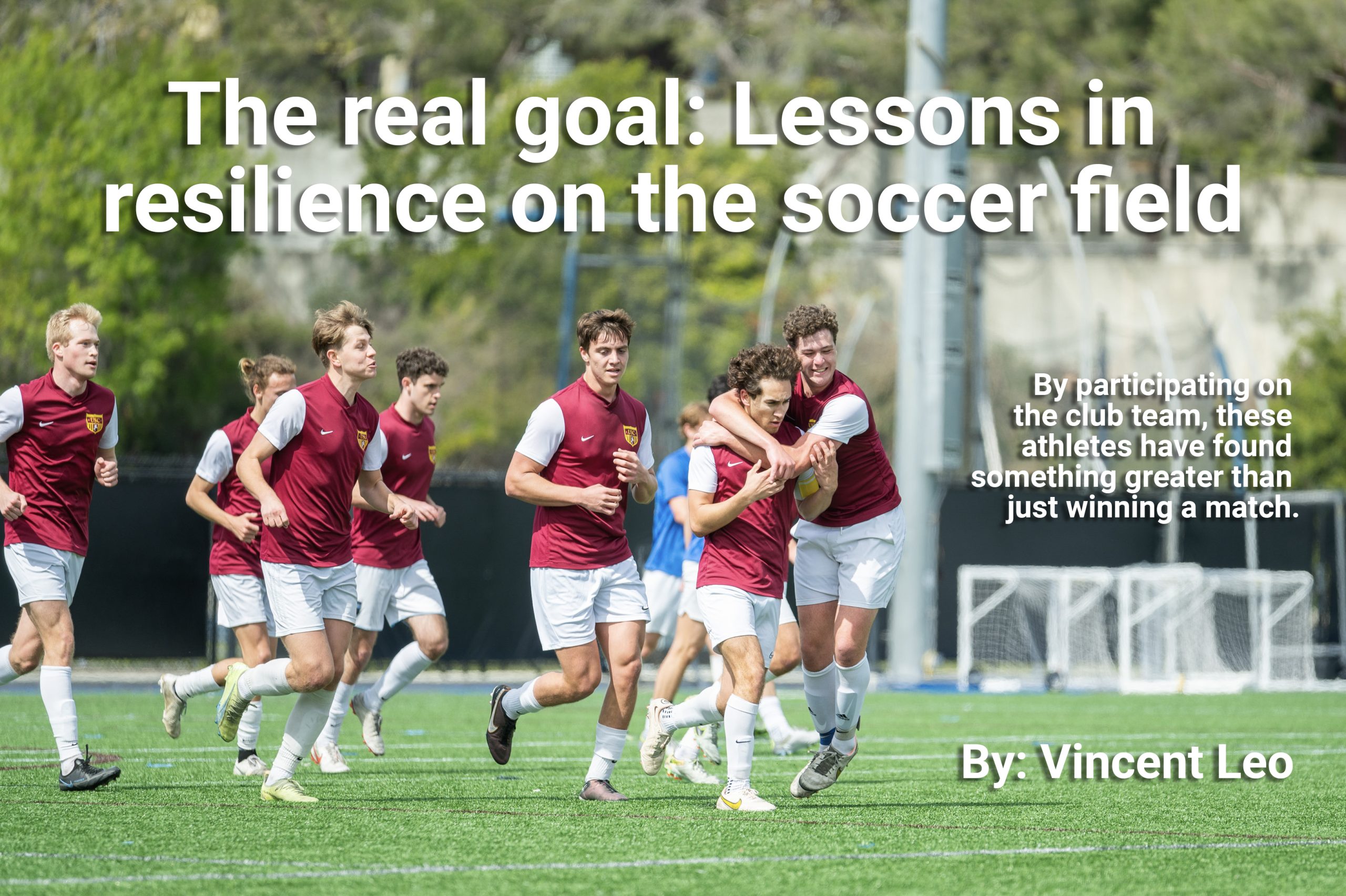
Down one goal to UCSD, the situation seemed bleak for the USC men’s soccer team, but victory remained within their grasp.
Stuart Young was leading the USC team for a final push in the last few minutes of the match. Could he tie up the score? Young went in for a defensive tackle to clear the ball out, but his opponent came in late, straight on Young’s ankle — and snap. The crunch left his foot at a 90 degree angle.
Young was quickly stretchered off and taken to the hospital, and USC fell short. Through the pain on the field, Young half-joked that he might not be able to play at next week’s game.
In the weeks that followed, reality set in: The team lost its leader and lacked motivation.
Young’s injury seemed to be the end for the USC men’s soccer team in 2017. They had no one at the helm and the players were going nowhere.
Most student athletes face such reality at various points in their brief athletic careers. Just 7% of high school athletes go on to play varsity in college, and a mere 2% make it into the highest level university sports, a Division I school, according to Scholarship Stats.com.
Out of all men’s soccer players, 99.93% do not make it to the pros. With so much failure, an athlete’s success must be redefined.
Perseverance yields success
Mario Jauregui Jr. rolls a stack of boxes 7-feet tall on his skateboard into an elevator at his off-campus apartment. After a few slow twists and turns, he maneuvers the boxes through the halls. He opens his apartment door and dumps them on the floor, immediately pulling out his keys to slice through the boxes’ protective tape.
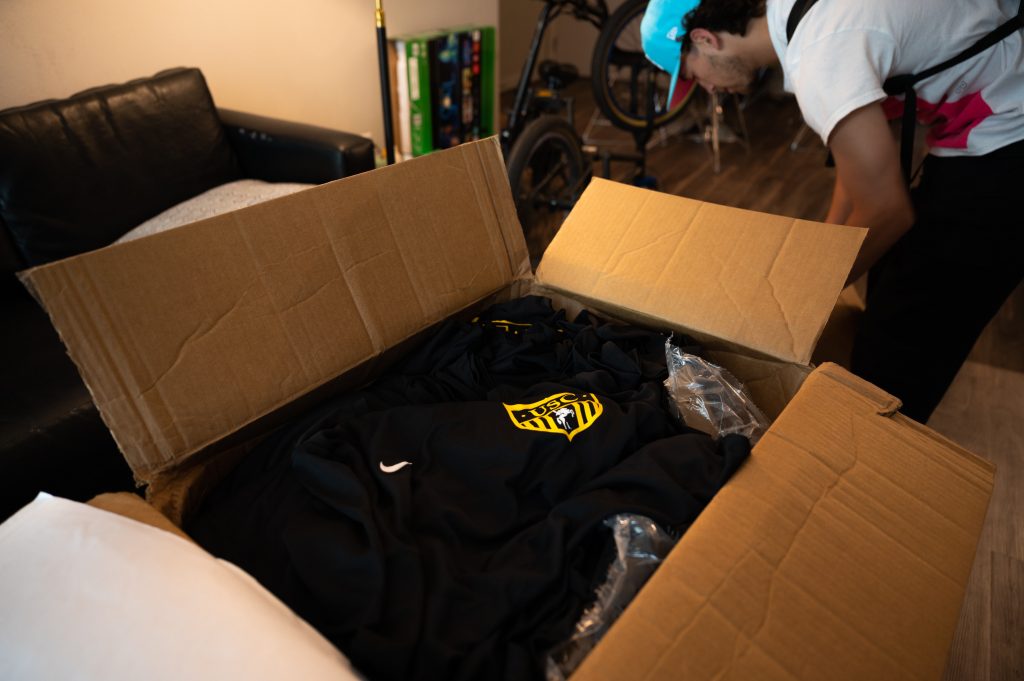
Jauregui Jr. reveals the new set of gear for the upcoming season.
“That’s so sick,” he says in awe.
The work Jauregui Jr. put in is finally paying off. After he and Nate Brody became co-presidents of the USC men’s soccer team in 2022, they quickly realized it wasn’t going to be an easy task. A year earlier, the team attempted to restore their winning identity and culture after players had been sent home during the COVID-19 lockdowns. They didn’t come back for two years.
The previous presidents were leading a team with new players making two-thirds of it. Jauregui Jr. and Brody were among these new recruits, listening and watching as the team sought to build chemistry.
There were other issues though. Without the knowledge of senior members who left during the pandemic, university funding for the club decreased drastically. For the past two years, the presidents did not know the club only receives more money if they spend what they get from the university, Jauregui Jr. said.
The team has resorted to charging their members around $400 to cover everything from jerseys to travel costs. However, they ran low on cash last semester and couldn’t make ends meet. Luckily, their coaches were there to lend a hand.
“We went to Texas last semester for the nationals and we weren’t able to fully cover everything. Transportation was roughly two grand that we didn’t have and our coaches covered it for us so we’re still in the process of paying that back,” Jauregui Jr. said.
Back at home, they also have to deal with another challenge: Practice times and facilities.
Although they were saved from last semester’s 10 p.m. to midnight practice slot, this spring’s 8 p.m. to 10 p.m. slot is still difficult on players and coaches after a long day. Even worse is that Allyson Felix Field, where practices and games take place, isn’t even a full length soccer field.
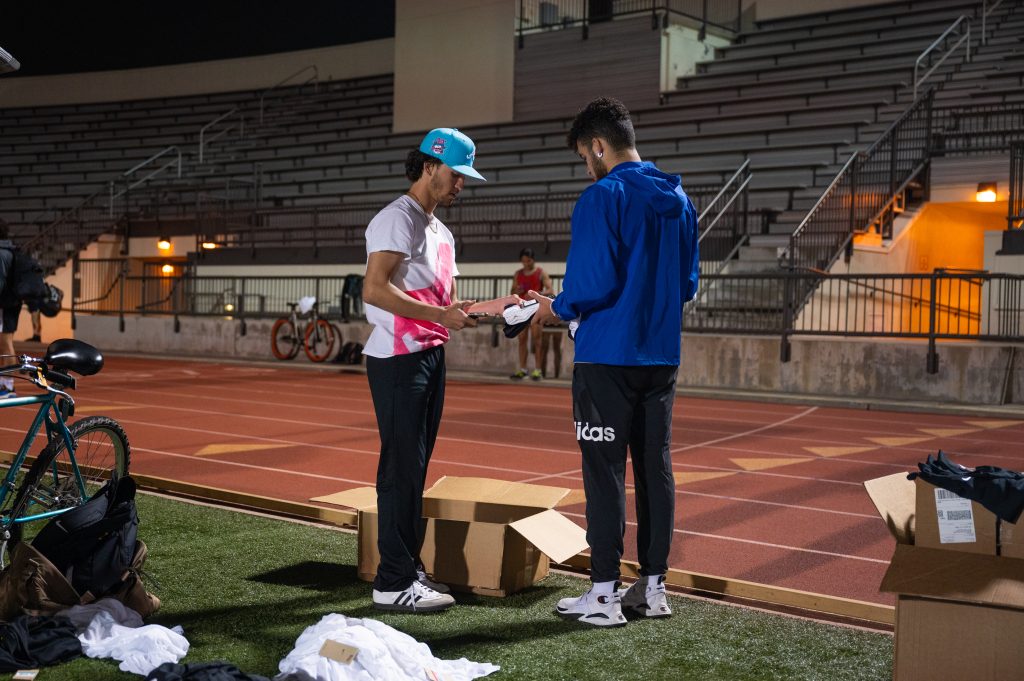
After practice, Jauregui Jr. hands out the gear to his players.
Even with the lack of resources, Jauregi Jr. maintains a grateful attitude about his time as president.
“It’s taught me a lot and helped me to grow as a person to just be appreciative of everything I do have and not be envious of the things I don’t have,” Jauregui Jr. said.
Brody said that he’s learned a lot more about leadership and creating a team that can push forward through adversity.
“I can’t tell you how many times last fall, this spring, we’ve scored game winners in the 80th minute and beyond. Other teams are breaking down and we’re still able to keep going. It’s things like that where in the moment, it sucks, but you’re doing it all for this purpose,” Brody said.
Repaying a favor
In 2017, the USC men’s soccer team was stuck in a coaching carousel — five coaches had rotated in and out the last four years. Morale was low and players had trouble motivating each other to get the team into shape.
That’s when Adam Maier realized something needed to change. Having played from 2010 through 2014 as an undergrad, he knew the team had potential, but didn’t run like it used to and decided to join the players again, this time as a coach.
“The guys were self-coaching sometimes and that’s where the program started to dip a little bit.” Maier said.
Since then, Maier has overseen the men’s team for seven years, eventually taking a backseat to let Nick Leach take over as head coach last fall. Leach also played on the team during the same years as Maier, both serving as presidents in their junior and senior years.
Even though it was a tough decision to step down, Maier knew that having a former teammate like Leach run the show was the necessary step.
“It’s like we’ve been in the trenches together. And we know that at the end of the day, we both just want what’s best for this team,” Leach said.
Their down-to-earth attitude and approachable personalities have led to a strong bond between the coaches and presidents.
“They are some of the best coaches I’ve had my entire life. They know when to be serious. They know when to have a good time,” Jauregui Jr. said. “So, it’s very easy to look up to someone who’s a great person.”

Leach and Jauregui Jr. discuss the next games and duties after practice finishes.
Brody has seen various styles of coaching, playing at Claremont McKenna’s Division III team before transferring to USC. He said that Leach and Maier’s ability to instill accountability, yet provide a place to have fun and grow is what makes the team a perfect environment.
“It’s just a perfect balance of respect as well as someone that you want to be around. Because I’ve been in a position where I’ve had coaches who’ve been super serious and they may have gotten the best out of us as players. But outside of that, they don’t get the best out of you as people,” Brody said.
Even though Jauregui Jr. recognizes the coaches have full-time jobs, they choose to stay for their love of the team. Leach said he will be connected to the club forever.
“You just care about them, and you want them to succeed, you want them to do well. And you want to remain connected to them,” Leach said.
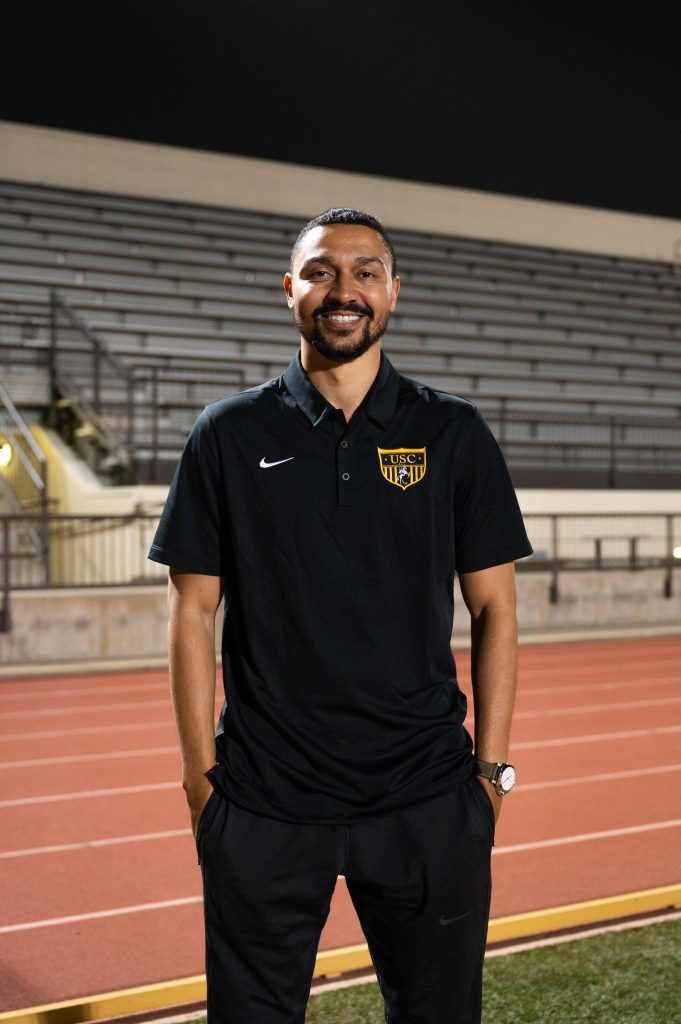
Nick Leach, USC men’s soccer head coach
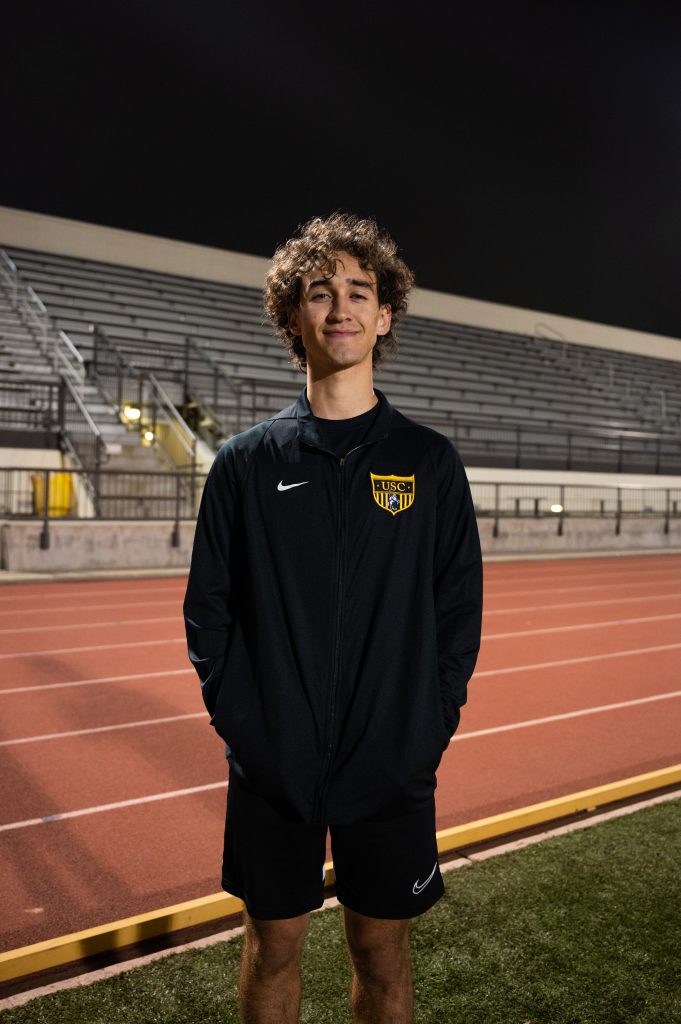
Mario Jauregui Jr., USC men’s soccer co-president
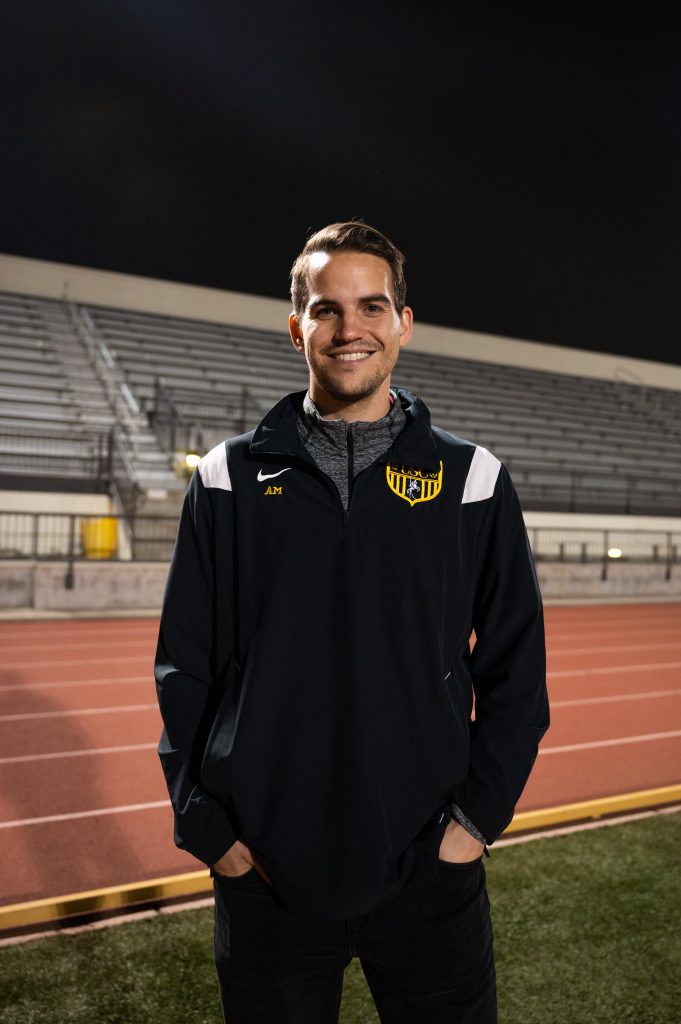
Adam Maier, USC men’s soccer assistant coach
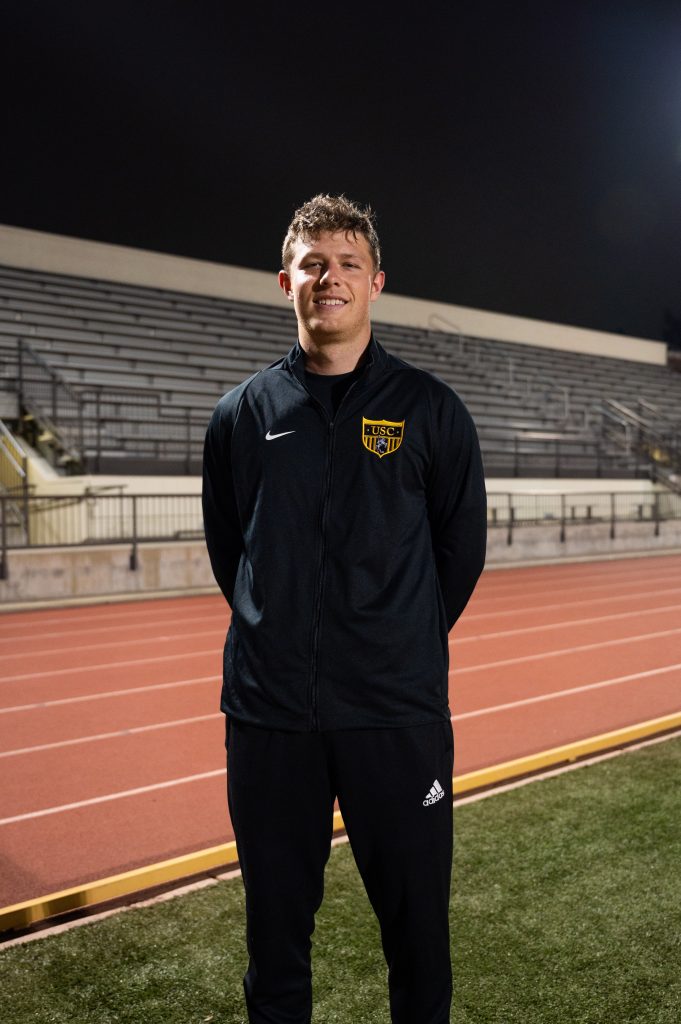
Nate Brody, USC men’s soccer co-president
Life after Allyson Felix Field
Located 30 minutes west of USC and tucked into a small corner outside of the Santa Monica Airport sits a small park with three soccer fields.
On the furthest field, a small group of guys don purple Hawaiian shirts, preparing for their match. They go by Mahalo, Hawaiian for expressing gratitude. All of them are USC men’s soccer alumni.
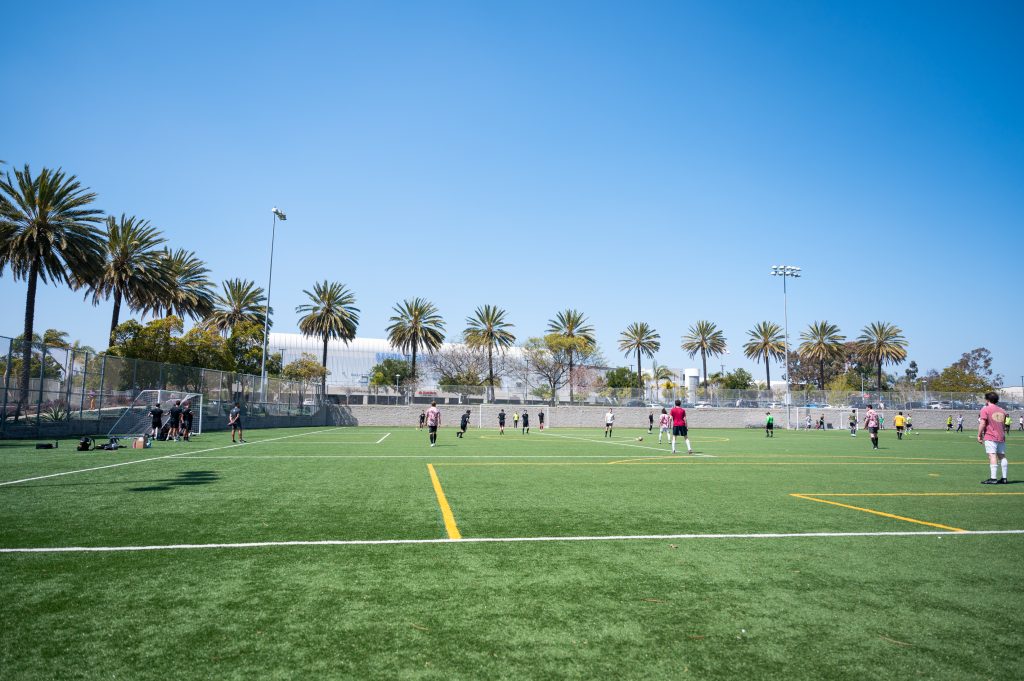
Mahalo plays their games at Airport Park, a field surrounded by lush palm trees and airport parking lots.
Even though players graduate from USC, they don’t have to say goodbye to their coaches. Mahalo is currently run by Maier, with Leach as an occasional player.
Giving the alumni a chance to strengthen their relationships, Maier describes Mahalo as an extension of the USC men’s soccer community.
“I really think one of the biggest things the [USC men’s team] can give anyone is a community — to give you brothers, to give you friends…There are a number of guys that I play men’s league with to this day [that] I coached with Nick. It can form a very tight knit group. It can give you friends for life,” Maier said.
Gabe Maceo, now part of Mahalo, graduated from USC in 2017 after playing on the team for three and a half years. He still keeps in touch with many of his former teammates and has celebrated plenty of milestones together.
“I’ve been to several weddings from the USC team. I can name off 10 guys that I know I want at my wedding. No question… It’s just this rolling thing. I’m sure there’s gonna be plenty more weddings in the future. But these are guys that I know. Whether it’s just me playing soccer with them for the rest of my life, that’s no question,” Maceo said.
Maceo describes the brotherhood the USC men’s soccer team and Mahalo bring as special, not only for kindling old friendships but meeting people from different generations whom he never played with.
“Maybe it’s your backpack, right? That has the USC men’s logo on it. ‘Oh, shoot, you play? What years did you play?’ You’re automatically hitting it off. You’re friends right away,” Maceo said.
Winning
Shouts and cheers rang out on Allyson Felix Field on a cold Monday evening as the men’s team scrimmaged with the women’s Division I squad.
USC was running on a high, having won seven of their eight games and finishing third in their League division. Coming within the top four meant they automatically qualified for the Spring Showcase, a revamped tournament deemed more important since the League season now covers the full calendar year instead of only the fall. With their eyes set on taking home a trophy, the team was amped and ready to hone their skills before the big weekend.
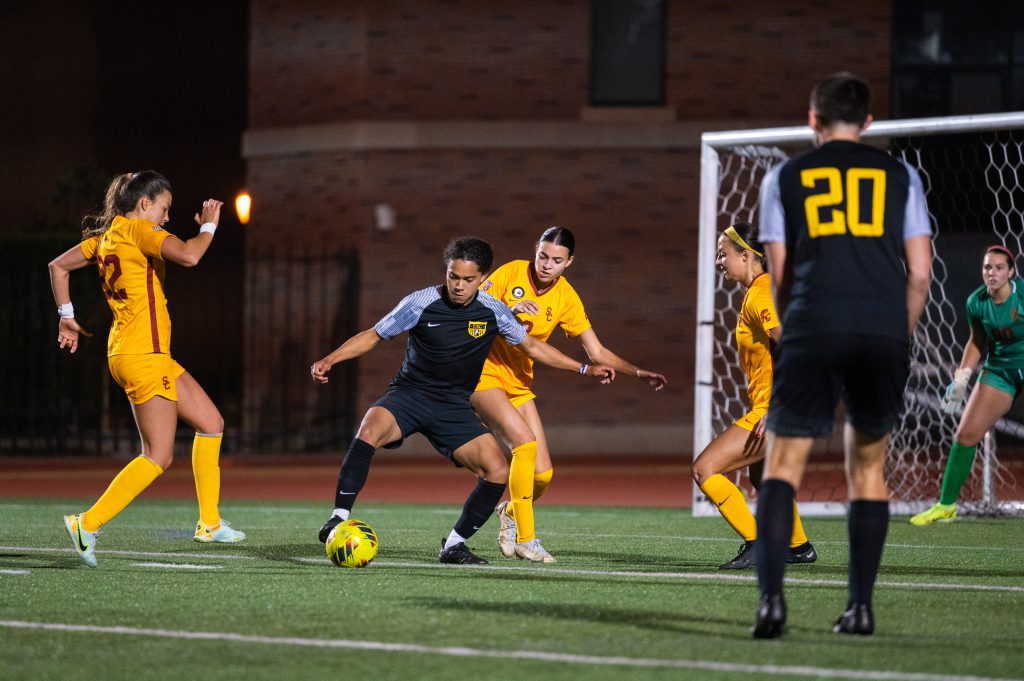
USC men’s soccer player Zach Hasksins fights to maintain possession during a scrimmage with the women’s Division I team.
This moment was a culmination of their hard work from the previous semester. Under Leach’s coaching, the USC men’s team had some of its best performances, including a 9-0 blowout win, and solidified themselves as returning regional champions.
Internally, Leach realized there were key changes he needed to make when it came to consistency — first tackling fitness by integrating running, sprinting and other agility work into every practice.
Discipline is one of things Leach scored big on. Before, players were showing up late to practices or not showing up at all, completely ruining Leach’s elaborate drills sometimes minutes before they started. Leach made every player sign a new code of conduct to hold them accountable, ensuring they must remain active and communicative with coaches so that practices and games don’t fall apart.
“These guidelines are now keeping the guys honest, in terms of being there and if they’re not going to be there, communicating, and doing so in a timely manner… Having discipline [during practices] will allow us to be more disciplined in the games,” Leach said.
Even in this club setting, players are expected to show up to all practices and give their best if they want playing time. It may seem harsh, but this is where Leach shines best, supporting the players through pointers and suggestions or providing hands-on experience when he’s playing goalie.
“[Nick really excels in] giving them that help, that support and advice on how they can get that playing time… [He focuses on] ‘here’s what we can work on.’ He looks out for that in the practices and we try to look out for that as much as possible in the practices to help the guys grow,” Maier said.
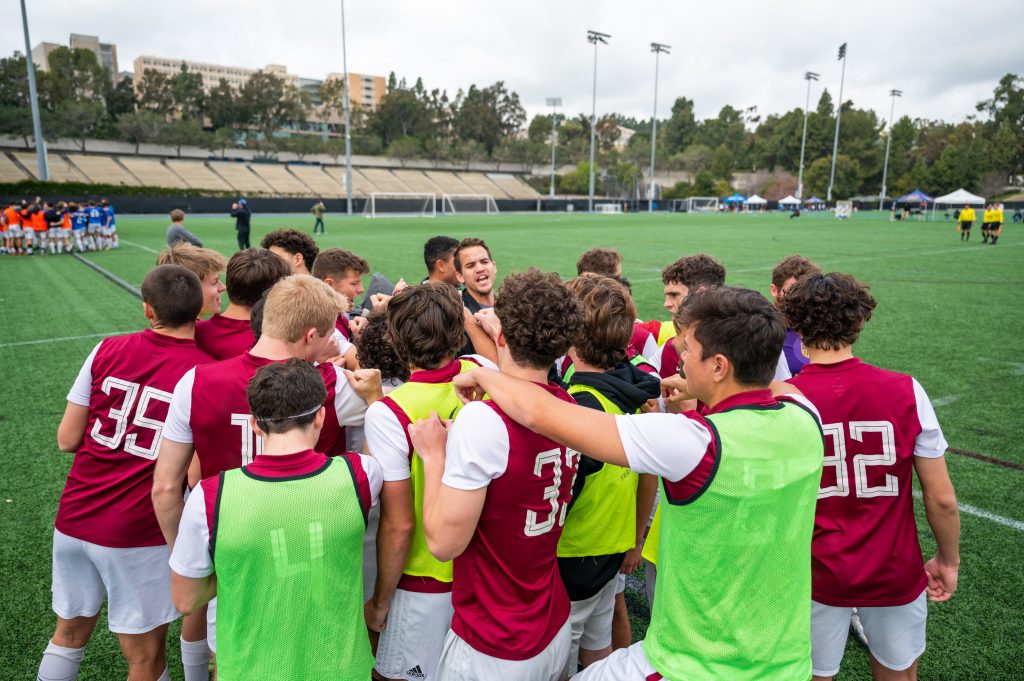
Maier leads a chant to hype up the team before their match against UCLA.
The team won their first two games and lost their third on a technicality in the Spring Showcase. Even if it ended on a dim point, the coaches remain filled with hope and see the tournament and this season as a springboard for next year’s bright future.
“For such a young team, that’s very impressive. We’ve seen a lot of teams come through over the years and I would say this is one of the best teams that we’ve seen in terms of quality across the board. There’s nobody on the team that we’d be shy about putting on the field. Every player kind of pushes the player next to them to a higher level,” Maier said.